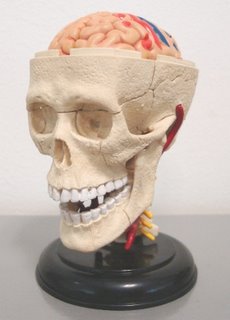 Prof. Martin Evans, a newly awarded Nobel Prize winner, came to Singapore in March 2004.
Prof. Martin Evans, a newly awarded Nobel Prize winner, came to Singapore in March 2004.He gave a talk in a research building which was then occupied by the Institute of Molecular and Cell Biology (IMCB).
Today that facility has been renamed after another Nobel uncle - it is now the Brenner Centre for Molecular Medicine.
The title of Prof. Evans' talk is - Embryonic Stem Cells: Uses and Sources.
Here is my summary of his main points:

1. He started by asking - what is the function of a genome?
A genome is necessary for the production of transcripts at the RNA level, and for making proteins, but Prof. Evans emphasized its importance at the phenotypic (or the organism) level.
The embryonic stem (ES) cell is a useful tool for examining phenotypic changes. In fact you can consider the ES cell as a vector to the whole animal's genome.
He noted that the ES cell is a developmental concept.
An early cell culture system used for studying developmental biology is the embryonal carcinoma (EC) cell, which is a type of tumour cell obtained from the embryos of animals such as the mouse.
EC cells have been available since the mid-1960's. While it is a very versatile cell type, EC cells have an abnormal number of chromosomes, thus limiting their biological relevance.
ES cells, on the other hand, maintain a normal chromosome complement over numerous population doublings. They were identified by Prof. Evans and colleagues in 1980, and have been widely used ever since.
ES cells can be isolated from a few sources. Usually obtained from the inner cell mass of a 3.5 day mouse blastocyst, it can also be isolated from a disaggregated 16-20 cell morula, or microdissected from the epiblast of a 4.5 day embryo.
To maintain these cells in a culture system, a number of factors can be used. Feeder cells (which are usually mouse fibroblast cells), conditioned media or a chemical called Leukaemia Inhibitory Factor (LIF) are necessary to keep ES cells in their undifferentiated state.
2. Prof. Evans then discussed a few salient issues in the field of ES cell biology.
He cautioned on the lax use of the term "stem cells" - which is reserved for true self-renewing cells.
He emphasized that precursor populations are not stem cell populations, and that both adult and embryonic stem cells reside in specific niches in the organism. It is not necessarily a straightforward task to maintain these niche conditions.
In the case of adult stem cells, some of these may be growing slowly towards a committed state, thus losing their stem cell-like properties over time.
Next Prof. Evans addressed a common question: are ES cells pluripotent (able to differentiate into all cell types of the embryo proper) or totipotent (able to differentiate into all cell types of the embryo + extraembryonic tissues)?
He believes that ES cells are totipotent, since experiments have shown that you can make extraembryonic endoderm and trophectoderm from them.
Prof. Evans then examined another question: are ES cells a normal cell type or a cell culture artefact?
He pointed out that the comparison of ES cells with inner cell mass (ICM) of embryos is difficult - you can have millions of ES cells in a dish, but each embryo has only about 20 ICM cells.
Thus the limited embryonic material must be amplified first in order to do microarray expression profiling. *(That was in 2004. Today there are robust methods for single-cell profiling).
More experimental data will help settle this question conclusively.
3. Finally Prof. Evans gave an overview of the current uses of ES cells.
Mouse ES cells have been used in gene knockout technology for studying gene function and for genetic engineering.
Prof. Evans stressed that due to ethical reasons, germline genetic manipulation in human beings must NOT be done.
Instead, the aim is to produce differentiated cells for therapeutic purposes.
Successful examples of cell types that have been produced via in vitro differentiation include pancreatic islet-like cells (to treat diabetes), germ cells and oocytes.
However in these cases, it is mainly achieved by the unsophisticated process of spontaneous differentiation, followed by selection.
He considered direct, transcription factor-driven transdifferentiation of the required cell type a more superior approach.
The ideal scenario would be the ability to de-differentiate adult cells and then re-differentiate into the required cell type. However, a large number of cells are needed for this, and today the only good way is to use ES cells as the starting material.
Prof. Evans ended his talk by pointing out that we need much better developmental biology and embryology before we can do good tissue engineering. Only mice and chick have fully validated ES cells - other mammals, such as pig and cow, have ES-like cells but do not respond to LIF and cannot be taken to germline.
Work done on these and other animals will help us understand the underlying biology of ES cell properties in greater detail.
Would you like to know more?
Details about gene targeting technology
- 2007 Medicine Prize: A Primer (by Matt Dowling)
Other Nobel uncle lectures
- Prof. Lee Hartwell (Cancer Biology)
- Prof. Yang Chen Ning (Particle Physics)
Nobel Prize exhibition
- What will you get if YOU win the prize?


2 Comments:
Hi Leng Hiong, very interesting article on Stem cells. I've featured your post in The Singapore Daily [singaporedaily.wordpress.com]. Keep blogging!
Hi Singapore Daily,
Thanks for featuring this article. Cheers!
Post a Comment